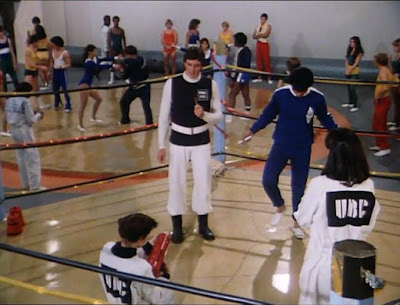Although
Star
Trek (1966-1969) is the cult-TV series best known for Cold War subtext
and social commentary, Buck Rogers in the 25th Century
(1979-1981) also delved into this artistic terrain at the end of the Carter Era
and at the beginning of the Reagan Era.
“The
Plot to Kill a City” -- the series’ finest episode -- was a powerful anti-nuke
statement, for example.
An
episode from later in the 1979-1980 first season, “Olympiad,” arrived with the
1980 Lake Placid Olympics, and also qualifies as a Cold War parable.
Those
real life games convened on February 14, 1980, and closed on February 24th. Thirty-seven nations participated, and more
than a thousand athletes competed. The highlight, of course, was the so-called “Miracle
on Ice,” wherein the U.S. ice hockey team unexpectedly defeated the Soviet
team, 4-3.
In
“Olympiad,” Buck Rogers (Gil Gerard) visits the distant planet Mikos for the
2492 Interplanetary Olympic Games. He
attends in an official capacity, to deliver a 20th century Olympics flag to the
games.
Once
there, however, Buck is asked by a lovely astro-sledder, Laura Teasian (Judith
Chapman) to help her secret lover, vertical jumper Jorex Leet (Barry McFadden)
defect to Earth.
Jorex
is a citizen of the repressive planet, Losira. The world’s tyrannical Satrap
uses athletes like him as propaganda tools to further his anti-freedom aims and
agenda. To assure total loyalty, Losiran citizens, including Jorex, are fitted
with “dis-harmonizer” devices in
their heads. These can cause headaches in the athletes, or be rigged to explode
their struggles.
Accordingly,
Buck must get Jorex away from Mikos before his disharmonizer can be activated.
In
disguise as an escort, Wilma (Erin Gray) attempts to get the dis-harmonizer
away from Jorex’s womanizing handler, Allerick (Nicolas Coster), but finds that
the device can’t be tampered with.
Buck
hatches a dangerous plan to outrun the device’s “zeta waves” by having Jorex
and Lara escape in her sled. Once they
escape the astro-slalom, Buck and Wilma’s starfighter will be waiting to bring
them through a stargate, and out of range of the disharmonizer.
I’ve
often described Buck Rogers in the 25th Century as “American Exceptionalism in Space,” with
Buck serving as the avatar for the authentic 20th century “real” American.
He is a grounded, skilled, heroic, funny
man of the 20th century who brings his wisdom to the repressed, buttoned-down,
computer-centric world of the 25th century.
The
irony, of course is that in the series continuity, the “real” Americans of the
20th century weren’t able to solve their problems peaceably, and
resorted to the holocaust, a nuclear war that all but destroyed the planet. There’s some exceptionalism for you!
Leaving
that point aside for the moment, this episode not only creatures a future
corollary for the Olympic Games of 1980, but sees Buck again demonstrating his
American-style superiority in terms of instincts, empathy and heroism. Although
he is a man five hundred years out of date, Buck successfully flies his Starfighter
through the astro sled slalom course (featuring force fields rather than snow…)
to rescue Jorex.
The
final slalom is a suspenseful scene, replete with Dr. Theopolis counting down
to the arrival of the fatal zeta waves. Buck and Wilma rescue the defector with
all of 2 seconds to spare.
The
episode’s “impossible mission”-type premise also finds Wilma going undercover,
like Cinnamon Carter on that Bruce Gellar series (1966-1972). She plays a 25h
century “escort” (read: prostitute) and incapacitates Allerick, only to find
her efforts are for naught. There’s a
blooper here regarding Wilma too. She uses the wrong name in a scene involving
Allerick and Jorex.
The
weakness, structurally, of Buck Rogers’s first season is the
fact that Buck is so often depicted helping a beautiful young woman on unofficial
missions of the type we see in “Olympiad” rather than exploring, for his own
reasons, his new century, future Earth, and learning more about the history he
missed.
In
other words, the stories involve Buck only at a very surface or superficial
level. We don’t learn anything about him, at least anything deep.
Yet
some series stories, (again, “Plot to Kill a City” and “Olympiad”) are able to
fill the character void with allegory or social commentary This episode, with
the planet Losira acting as a latter-day Soviet Union, and Buck acting as an
agent for the West (the Defense Directorate) is certainly entertaining, and
gives the episode an added layer of significance and relevance to the audience
of 1980.
All
the futuristic sports touches -- clearly tongue-in-cheek – give the episode, a
jaunty, light-hearted feel as well.
In
addition to the astro-sledding -- the coolest, most imaginative aspect of “Olympiad”
– we see “sonic boxing,” the “vertical leap,” and weight lifting in a “Gravity
pool.” Again, perhaps not strictly
plausible, but nonetheless imaginative and droll.
A
lot of cult-TV series in the 1970s featured defectors from “The Iron Curtain,” but it’s
intriguing how Buck Rogers puts a spin on that familiar tale.












No comments:
Post a Comment